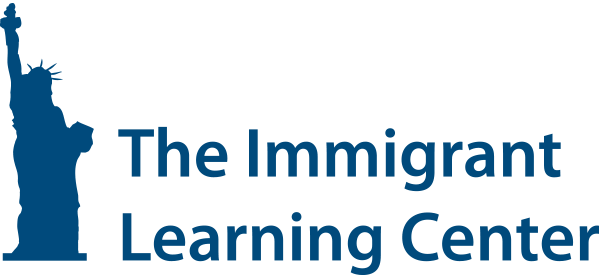In the face of discrimination and misguided policies, LGBTQ+ immigrants and refugees have fought for recognition and liberation. The battles they won have had positive ripple effects and not just for people in queer or in immigrant communities. The earliest fights for marriage equality were led by bi–national, same-sex couples who needed their relationships recognized for immigration purposes. Every identity under the LGBTQ+ umbrella has had to campaign to expand asylum rights to include them. When the federal government banned HIV+ people from entering the United States, immigration and queer advocacy groups joined forces to wage a successful, decades-long fight against the ineffective and stigmatizing policy. A limited interpretation of birthright citizenship disproportionately affected queer immigrants, so gay and lesbian parents fought to ensure all parents can pass on their U.S. citizenship. While the intersection of LGBTQ+ and immigrant identities can produce multiple challenges, it can also create opportunities to fight for changes that benefit everyone.
LGBTQ+ Immigrants in United States History
Queer immigrants were first banned from the United States in the 1952 Immigration and Nationality Act (INA), which barred anyone with a “psychopathic personality” from immigrating to the United States. The bill’s authors always intended for gay people to be excluded under this clause, but the ban was strengthened when the INA was revised in 1965 to explicitly affirm that “sexual deviation” was a form of “psychopathic personality.” The law came in the wake of the “Lavender Scare,” a period in which the federal government attempted to root out potentially “subversive” queer government workers as part of the Cold War effort. In 1966, a judge argued against the law, saying that it would ban people like “Sappho, Leonardo da Vinci, Michelangelo” and perhaps “more than a few members of legislative bodies.” Despite this, the policy remained in place until 1990 when Congress passed the Immigration Act of 1990 to revise and reform the U.S. immigration system.
U.S. Representative Barney Frank, who served from 1981 to 2013 and was the country’s first openly gay congressperson, co-wrote the 1990 act and lifted the ban on gay and lesbian immigrants by simply not including the exclusionary language in the new law. The same year, the United States began accepting asylum seekers on the grounds of persecution for sexual orientation, although it has done so inconsistently. Transgender migrants were often perceived as cisgender gays or lesbians, and the first policies addressing their specific circumstances didn’t arrive until the 21st century. Against this backdrop of discriminatory laws and muddled policies, LGBTQ+ immigrants made enormous contributions to the causes of queer rights, immigration rights, queer immigration rights and the United States as whole.
For a broad overview of the current circumstances of queer immigrants, check out this discussion of how sexual orientation and gender intersect with the immigrant experience, featuring Immigration Equality attorney Amitesh Parikh, from The ILC Public Education Institute’s 2020 virtual conference Uniting Immigration with Other Social Causes:
Terms and Definitions, courtesy of GLAAD
Cisgender: An adjective used to describe people who are not transgender. A cisgender person is a person whose gender identity is aligned with the sex they were assigned at birth.
Intersex: An adjective used to describe a person with one or more innate sex characteristics, including genitals, internal reproductive organs, and chromosomes, that fall outside of traditional conceptions of male or female bodies
LGBTQ+: Acronym for lesbian, gay, bisexual, transgender, and queer or questioning. The “+” is in recognition of all non-straight, non-cisgender identities.
Nonbinary: An adjective used by people who experience their gender identity and/or gender expression as falling outside the binary gender categories of man and woman.
Queer: An adjective used by some people whose sexual orientation is not exclusively heterosexual. Typically, for those who identify as queer, the terms lesbian, gay and bisexual are perceived to be too limiting and/or fraught with cultural connotations they feel do not apply to them.
Transgender: An adjective to describe people whose gender identity differs from the sex they were assigned at birth
Contributions of Queer Migrants
Tracking the many contributions of queer immigrants is complicated by the fact that many of these contributions were doubtlessly made by immigrants who weren’t openly queer. Under the bans on LGBTQ+ immigrants, only people who were willing and able to hide their identities could legally immigrate. For more on this topic, see the sidebar.
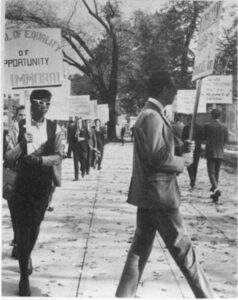
The immigrant-founded Mattachine Society picketed the White House in 1965 in support of queer rights. Photo by Kay Tobin Lahusen. Courtesy of the New York Public Library Digital Collection. Permanent link at NYPL: digitalgallery.nypl.org/nypldigital/id?1605764
Queer and immigrant rights groups have a long track record of solidarity, shared interests and mutual benefits. The first gay rights group in the U.S., The Society for Human Rights, was founded by Henry Gerber, a German American immigrant. It was his experience with the early gay rights movement and activists in Germany that inspired his own activism. Though the organization was soon shut down by obscenity laws, Gerber’s work directly influenced other gay rights activists, including Harry Hay, an English American immigrant and founder of the Mattachine Society, the first lasting gay rights organization.
As both restrictions and stigma have lifted, queer immigrants have had more opportunities to live and contribute openly to the United States. Academy Award-nominated actor and Canadian American immigrant Elliot Page became the first openly trans man to appear on the cover of TIME Magazine. Outspoken journalist and activist Masha Gessen fled Russia following persecution for their nonbinary and queer identity. British-born lesbian Ruth Gates made landmark discoveries as a marine biologist that have shaped the future of coral reefs. Israeli American immigrant entrepreneur Joel Simkhai launched a dating app that now has millions of users. Filipino American Jose Antonio Vargas found coming out as undocumented more daunting than coming out as gay and channeled his frustrations into journalism, filmmaking and founding the immigration not-for-profit Define American. When they aren’t modelling for international brands, Belgian-born intersex and nonbinary model Hanne Gaby Odiele advocates on behalf the intersex community. As understanding and acceptance of LGBTQ+ people grow, more and more queer immigrants to the United States will have the opportunity to live and contribute openly to their new home.
Visibility:
Gender identity and sexual orientation can be easier to hide than other characteristics that U.S. immigration law has historically discriminated against, such as nationality or disability. “Passing” as straight and cisgender is not possible or desirable for all immigrants, though. When a border guard decided that Mexican American migrant Sarah Harb Quiroz looked like a lesbian, he interrogated her and discovered his suspicions were correct. She was subsequently deported. For some trans people, attempting to present as the incorrect gender can be intolerable. Staying closeted can also have significant negative mental health effects. Visibility is a complex issue for queer immigrants.

Canadian-born actor, producer, author and champion of queer and trans rights Elliot Page was named by Time Magazine as one of the 100 Most Influential People of 2024. Photo by Shawn Miller/Library of Congress.
HIV/AIDS Ban
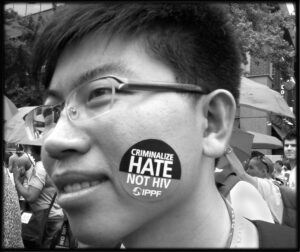
Photo by scottmontreal. Permanent link at https://www.flickr.com/photos/scottmontreal/7654401708
In 1987, President Reagan instituted a ban on people infected with HIV/AIDS entering the country. The ban fell most heavily on gay men who would otherwise have been able to legally immigrate after 1990. While HIV/AIDS is not the only medical condition or disability barred by immigration policy, the ban was widely seen as discriminatory, particularly after it became clear that the disease was already widespread in the United States and couldn’t spread through casual contact.
Gay rights and immigrant rights groups collaborated to fight the ban. In 1989, Hans-Paul Verhoef, a gay, Dutch, HIV-positive activist, was detained after an airport security guard found AIDS medication in his luggage. Verhoef was on his way to attend a conference on HIV/AIDS work, and when the conference-goers heard about his detainment, they protested and brought attention to his plight. Verhoef was eventually released and allowed to attend the conference, but his subsequent legal challenge to the ban failed. Openly gay Congressperson Barney Frank and gay rights groups joined immigrant rights groups in their unsuccessful calls to lift the ban. It was not until 2010, long after it was well-established by scientists that the illness could not be spread through casual contact, that the ban was lifted.
While the legal barriers have fallen, discrimination remains. Medical care is often poor and inconsistent in immigrant detention facilities, something that can prove devastating for HIV-positive migrants. Asylum seekers can have their medications confiscated, and even a short-term interruption in HIV medications can have significant negative effects. HIV-positive migrants are sometimes housed in isolation in a misguided attempt to prevent the infection from spreading, in some cases even separated from their families. In more promising news, asylum is now sometimes granted on the basis of HIV status.
Marriage (In)Equality and Immigration

Edie Windsor successfully fought to have her marriage to Thea Spyer, a Jewish refugee and acclaimed clinical psychologist from The Netherlands, recognized by the federal government. The case effectively ended DOMA.
source: By Rex Block – https://www.flickr.com/photos/76918035@N00/34470813494/, CC0, https://commons.wikimedia.org/w/index.php?curid=62393533
Immigrants have been part of the fight for marriage equality since the beginning. Without it, same-sex couples were denied an important pathway for legally immigrating to the United States, marriage to a U.S. citizen. The first challenge to the status quo came in 1975 when a county clerk in Boulder, Colorado, used a loophole in the state constitution to offer marriage licenses to six gay couples. One of these six marriages was between Richard Frank Adams, a naturalized U.S. citizen from the Philippines, and Anthony Corbett Sullivan, who was in the U.S. on a tourist visa from Australia. The couple petitioned the U.S. Immigration and Naturalization Service to classify Sullivan as an “immediate relative” of Adams so that he could obtain a green card. Their petition was denied by a letter that read, in part, “You have failed to establish that a bona fide marital relationship can exist between two f—–s [anti-gay slur].” After filing a complaint, the couple received an apology for the language, but not a green card. The couple’s ensuing lawsuit, “Adams v. Howerton,” was a landmark case for gay rights. Though the suit failed, it marked the first lawsuit for recognition of a same-sex marriage from the federal government.
Although some states began recognizing same-sex marriages as early as 2004, the federal 1996 Defense of Marriage Act (DOMA) prevented federal immigration authorities from recognizing those marriages in immigration cases. The Supreme Court struck down DOMA in 2013, but it wasn’t until the Obergefell v. Hodges case in 2015 that same-sex marriages were legalized and recognized by all levels of government across the country. The first same-sex couple to receive a marriage-based green card received approval within days of the court’s decision. Anthony Sullivan received his green card more than 30 years after first applying.
While this ruling finally put LGB immigrants on the same legal footing as their heterosexual peers, other obstacles remained. Immigrants must provide immigration officials evidence their marriage is “bona-fide.” If the non-citizen partner comes from a country where their sexual orientation is persecuted or even criminalized, they might have actively avoided creating evidence of their relationship. Without pictures of themselves together or the testimony of supportive friends or family, same-sex couples can struggle to prove that their relationship is “bona fide.” In some cases, couples have had to resort to filming themselves having sex.
Birthright Citizenship
Andrew Dvash-Banks, an American Canadian dual citizen, and Elad Dvash-Banks, an Israeli Canadian immigrant, were horrified to discover that only one of the fraternal twins they had conceived via a Canadian surrogate was recognized as a U.S. citizen. The State Department maintained that since Ethan Dvash-Banks shared no genetic connection to his American father, he couldn’t inherit his father’s citizenship. Since 1934, the United States has upheld a citizenship policy of “jus sanguinis,” or “right of blood.” A child born to a U.S. citizen automatically inherits their parent’s citizenship, regardless of where in the world they are born, provided the parents are married. If a baby is born “out of wedlock” and the citizen parent is not married to the birthing parent, evidence of a biological connection is required. Until 2021, a child born to a surrogate, like many children of same-sex couples, was considered “out of wedlock.” Immigration Equality, an organization focused on the rights of LGBTQ+ immigrants, successfully sued the federal government on behalf of the Dvash-Banks and other families in similar situations. The government now recognizes all married couples as the parents of their offspring, regardless of the circumstances of conception. The ruling was on behalf of a gay couple, but it expands and solidifies birthright citizenship for any parent in a similarly non-traditional situation.
Seeking Asylum
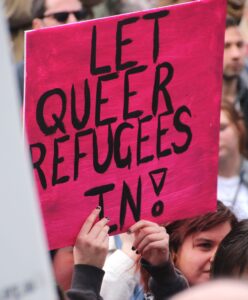
Photo by John Englart. Permanent link at https://www.flickr.com/photos/takver/9374730031
In 1990, a gay Cuban immigrant fought his impending deportation on novel grounds. Fidel Armando Toboso-Alfonso argued that he shouldn’t be deported because the Cuban government had persecuted him for being part of a “particular social group.” While Toboso-Alfonso lost his individual case due to a previous criminal conviction, the Board of Immigration Appeals declared persecution of “homosexuals” was an acceptable basis for asylum. In 1994, this decision was declared to be a binding precedent for asylum decisions.
The Toboso-Alfonso decision arrived six months before the Immigration Act of 1990 ended the ban on LGB immigrants to the United States. This was an era in which many states in the U.S. still had anti-sodomy laws on the books. Perhaps unsurprisingly, asylum on the basis of queer identity was granted rarely at first and is still granted inconsistently. Rates of people applying for asylum on the basis of the gender identity and sexual orientation have steadily increased, but steep challenges remain.
The asylum process sometimes lacks empathy and understanding of the experiences of queer asylum seekers who have had to fight hard for recognition. Some judges have argued that the government shouldn’t offer asylum for characteristics that the applicant could choose to hide, ignoring the difficulty and high cost of staying closeted. In one case, a judge claimed that a man who had previously had a relationship with a woman could not be queer, ignoring the possibility of bisexuality, social pressure or closetedness. Bisexual asylum seekers have been encouraged to apply for asylum as a gay or lesbian person since some judges argue that bisexual people can choose to only have relationships with the opposite sex. Asylum seekers may also come from cultures with a different understanding of gender identity and sexuality, limiting their ability to communicate their circumstances to a judge.
“Proving” their sexuality or gender identity carries its own set of challenges for asylum seekers. Judges sometimes evaluate the asylees using their own stereotypes of how gay and lesbian people look, sound and behave. Since they are fleeing persecution, many queer asylum-seekers do not have evidence of their identities. Queer asylees are also required to prove that they’ve faced persecution or violence related to their gender or sexual identity and have reason to believe that the mistreatment will continue. Queer women often apply for asylum on the basis that they’ve endured domestic violence or “corrective” rape, but some are attempting to migrate from countries where this gendered violence is common, making it difficult to prove a connection to their marginalized identity. Transgender asylees may face the additional hurdle of proving their identities to judges who have a poor understanding of gender identity. One judge denied an asylum claim from a transgender Mexican American immigrant in part because gay marriage is legal in some regions of Mexico, a related but distinct issue from gender identity. For a more detailed discussion of transgender asylum issues, see the section on transgender migrants below.
These factors may be why people seeking asylum on the basis of sexual orientation or gender identity obtain asylum at lower rates than other asylum seekers. To this day, gay and lesbian people face legal discrimination in almost 80 countries and, in some cases, it is punishable by death. In even more countries, transgender people face discrimination, persecution and violence. As the rates of LGBTQ+ people applying for asylum status continue to rise, improving understanding of queer issues within the asylum system is increasingly vital.
Transgender Immigrants and Asylum Seekers
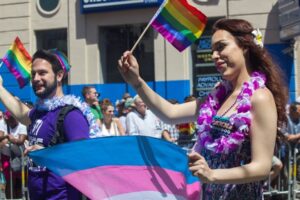
Pride march attendees wave a transgender pride flag.
Photo by Quinn Dombrowski. Permanent link at https://www.flickr.com/photos/quinnanya/14536760251
The path to legal equality has been even slower and bumpier for transgender immigrants than for gay, lesbian and bisexual immigrants. The government’s evolving understanding of gender identity and how it relates to sexual orientation has led to some confusing, inconsistent policies. In the landmark 2000 case Hernandez-Montiel v. INS., a transgender woman successfully applied for asylum on the basis of the persecution she faced in Mexico. The decision was a hard-won triumph for Geovanni Hernandez-Montiel, but it didn’t settle the question of whether transgender people could use gender identity to apply for asylum. Hernandez was incorrectly identified in the decision as a “gay man with a female sexual identity.” Nonetheless, the decision was used as precedent by other female transgender asylum seekers, in part because homosexuality was a comparatively safe, established basis on which to apply for asylum. Subsequent cases have slowly made transgender asylees’ right to asylum clearer.
In 2003, the Department of Homeland Security, then in control of immigration, adopted a position of not recognizing marriages that included a trans partner. In 2004, the government formally issued a new policy to not recognize any marriage “between two individuals where one or both of the parties claims to be a transsexual.” The ban was lifted in 2005, but trans immigrants’ marriages were only recognized if they were in a relationship that the government perceived as heterosexual. United States Citizenship and Immigration Services evaluated married trans people’s gender on the basis of whether they were “pre-operative” or “post-operative.” Using medical transition as a marker of people’s gender excluded many immigrants who didn’t want or couldn’t access gender affirmation surgery. In 2015, with the legalization of same-sex marriage, trans people’s gender became irrelevant to having their marriages recognized. Their right to immigrate on the same terms as cisgender immigrants is legally affirmed.
Transgender people still face barriers in the immigration process. Immigrants are often divided by gender in immigration detention facilities, and trans immigrants are often sorted wrongly, despite federal guidelines recommending otherwise. Sometimes they’re housed in isolation for their “protection,” despite the devastating psychological toll this can take. Trans women are detained up to twice as long as immigrants on average. Trans immigrants are also at a sharply elevated risk of abuse and sexual violence.
Intersectional Challenges
The intersection of queer and immigrant identities can create multiple challenges for queer immigrants. Rates of trauma and mental illness are significantly higher for both immigrants and LGBTQ+ people. This is especially true for refugees, who have faced some degree of trauma by definition. Queer immigrants are 97 times more likely to face sexual assault in immigration detention than cisgender, heterosexual immigrants. Accessing mental health care to address trauma and mental illness can be challenging. LGBTQ+ people sometimes struggle to find a queer-affirming mental health practitioner. Immigrants often face language barriers and may not qualify for government health insurance programs.
It has been illegal to discriminate against immigrants in the workplace since 1986, but this has not stopped widespread discrimination. Workplace discrimination against queer people was banned in some states starting in 1982, but it wasn’t illegal at the federal level until 2020. Losing a job is particularly dangerous for immigrants who are more likely to be in a financially precarious situation and may even have their immigration status tied to their employment. Lack of financial security is particularly dangerous for asylum seekers. Asylum claims for LGBTQ+ immigrants can cost between $6,000-$15,000 without any promise of success.
LGBTQ+ people and immigrants both sometimes face discrimination at the hands of the police. For immigrants for whom arrest can mean detainment and deportation, this is especially dangerous. In one famous case, Diego Viñales was arrested in a 1970 police raid of a gay bar, during which patrons were verbally abused and subjected to anti-gay slurs. Viñales was an undocumented immigrant from Argentina. Fearing deportation, he attempted to escape by leaping from a second story window of the police precinct. He endured serious injuries, sparking waves of protests and a significant political backlash to the then-common practice of targeting gay bars for raids.
Queer Immigration’s Legacy
Expanding the rights of any marginalized group is liberating for all people. Where immigrant and queer causes intersected, solidarity between the groups has led to improved conditions for everyone. When the HIV/AIDS ban disproportionally impacted queer and immigrant communities, a coalition of more than 400 organizations campaigned until it was repealed for all HIV-positive people. Richard Frank Adams’ lawsuit to have his marriage to his immigrant partner recognized publicized the issue of marriage equality and laid the groundwork for many lawsuits to come. When a narrow, outdated interpretation of birthright citizenship negatively impacted queer immigrant families, the ensuing legal fight established a more inclusive definition of “parent” for all families. The story of queer immigration is one that all Americans can benefit from.
More Resources
- Organizations like Immigration Equality and LGBT Asylum Project have educational resources to expand your knowledge of queer immigration issues.
- The Immigrant Legal Resource Center maintains a collection of resources for LGBTQ+ immigrants, with a focus on legal resources.
